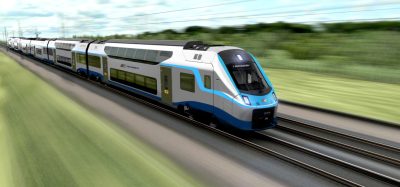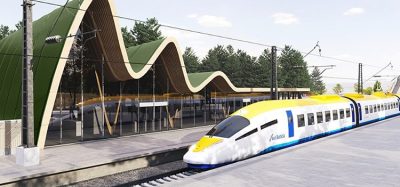CETEST: Test services for commuter, long distance and high-speed railway vehicles
Posted: 6 December 2011 | | No comments yet
CETEST Test and Analysis Centre is an independent accredited laboratory focusing on the testing of railway vehicles. With headquarters in the North of Spain, we are a global company serving a diversity of customers ranging from railway undertakings (operators), system integrators (vehicle manufacturers) to equipment sub suppliers. The tests we perform cover the full spectrum of rail vehicles including urban transport (tramways and light-rail vehicles), commuter rail (both electrical and diesel multiple units), long distance and high-speed as well as locomotives and freight wagons. These tests are performed in specialised test benches at our facilities as well as while running on track depending on the nature of the need.
Our growth in recent years has followed the tendency on the railway sector for more testing in all projects worldwide. The increase in complexity and quantity of testing required grows as service level demands increase: more reliable systems and vehicles, higher speeds, better comfort, improved energy efficiency, increased safety levels etc. Also, testing needs grow as we move into the implementation of the common European regulations and all projects are required to undergo tests to check for compliance with common norms and limits.
CETEST Test and Analysis Centre is an independent accredited laboratory focusing on the testing of railway vehicles. With headquarters in the North of Spain, we are a global company serving a diversity of customers ranging from railway undertakings (operators), system integrators (vehicle manufacturers) to equipment sub suppliers. The tests we perform cover the full spectrum of rail vehicles including urban transport (tramways and light-rail vehicles), commuter rail (both electrical and diesel multiple units), long distance and high-speed as well as locomotives and freight wagons. These tests are performed in specialised test benches at our facilities as well as while running on track depending on the nature of the need. Our growth in recent years has followed the tendency on the railway sector for more testing in all projects worldwide. The increase in complexity and quantity of testing required grows as service level demands increase: more reliable systems and vehicles, higher speeds, better comfort, improved energy efficiency, increased safety levels etc. Also, testing needs grow as we move into the implementation of the common European regulations and all projects are required to undergo tests to check for compliance with common norms and limits.
CETEST Test and Analysis Centre is an independent accredited laboratory focusing on the testing of railway vehicles. With headquarters in the North of Spain, we are a global company serving a diversity of customers ranging from railway undertakings (operators), system integrators (vehicle manufacturers) to equipment sub suppliers. The tests we perform cover the full spectrum of rail vehicles including urban transport (tramways and light-rail vehicles), commuter rail (both electrical and diesel multiple units), long distance and high-speed as well as locomotives and freight wagons. These tests are performed in specialised test benches at our facilities as well as while running on track depending on the nature of the need.
Our growth in recent years has followed the tendency on the railway sector for more testing in all projects worldwide. The increase in complexity and quantity of testing required grows as service level demands increase: more reliable systems and vehicles, higher speeds, better comfort, improved energy efficiency, increased safety levels etc. Also, testing needs grow as we move into the implementation of the common European regulations and all projects are required to undergo tests to check for compliance with common norms and limits.
The areas of expertise that we cover at CETEST make us one of the leaders in Europe in railway testing. These can be grouped and listed as:
Join our free webinar: Rail cyber-security in a time of technological and regulatory transformation
Join our expert panel, including speakers from Nokia and Siemens Mobility, to explore the critical convergence of cybersecurity and 5G rail comms.
Date: 3 Dec | Time: 15:00 GMT
Can’t attend live? No worries – register to receive the recording post-event.
- Structural testing (both static and fatigue) of large structures and small components
- Vehicle ride dynamics u Vibration and modal testing (including operational modal testing)
- Electromagnetic compatibility u Acoustics and aerodynamics
- Energy collection and energy efficiency.
In order to see how we carry out our verification testing activities in these areas we will divide these activities into two types of categories according to the point in the vehicle life when the test is performed. In this way we can distinguish between tests related to the design and acceptance of new components and vehicles and tests related to the operation and revenue service of the train (including vehicle rehabilitations). Let us explore some examples of tests that we perform on commuter and long distance vehicles to explain these.
Tests related to component design verification and vehicle acceptance
The customers for these tests are normally system integrators and equipment sub suppliers. Designs need to be tested as part of their verification process and all systems checked in order to obtain acceptance and therefore authorisation to enter into service. To follow is a presentation of four examples of tests we perform related to this category:
Structural testing of car body shells
The structure of the car body is subjected to a variety of loads (vertical, longitudinal, lateral) during its lifetime. Designers must take this into account and computer calculations via Finite Element Models (FEM) are made in order to study the effect of these loadings into the structure. Even if FEM calculations have advanced significantly in the past decade, still standards call for a full scale static test of the structure before vehicles enter service. These tests are of non-destructive nature, that is, the frame under test will return to the production line after test completion.
Structural testing of bogie frames
Likewise to the structure of the car body, the frame of the bogie is also subjected to a variety of loads during its lifetime. These loads are severe and of repetitive nature, i.e. will cause the structure to fail not only under extreme loading conditions but also in fatigue failure modes. Therefore FEM calculations as well as tests need to tackle these characteristics: static and fatigue tests are performed on the bogie frames to simulate its full life under service: up to 10 million cycles of combined loading must be applied according to standards. Therefore these tests are destructive and the frame under test is scrapped at the end of the campaign.
Vehicle dynamics testing
The running behaviour of commuter and long distance rail vehicles is of utmost importance since it does concern both the comfort levels passengers experience during their ride as well as the safety of the vehicle itself whilst running on the network. At CETEST we perform both static evaluations at specialised test benches and tests on-track.
Before vehicles are allowed to first enter the tracks for the dynamic testing phase, several tests to the suspension must be performed according to international standards. These include tests to characterise primary and secondary suspension flexibility, wheel offloading and rotational resistance between bogie and car body. The results of these tests help understand and verify key parameters such as curving behaviour or safety against derailment before the vehicle ever runs. Safety can never be underestimated.
Of course testing on track is the only absolute way to ensure total safety and system compliance. For this we instrument the train with accelerometers, strain gauges, displacement sensors, gyroscopes, position and speed sensors, etc. Instrumentation is placed at different levels from wheel set to primary and secondary suspension, bogie frame and up in the car body. In this way we can evaluate the contribution of all components and subsystems to the overall running safety and to the comfort levels that the passengers will experience. Our field test group is split in teams that travel around the world performing this type of tests (as well as other field tests of course). In 2010 we performed tests in projects in five continents! Speaking of vehicle dynamics tests, it is fair to bring to the attention of the reader a special measurement system called an Instrumented Wheel Set which is employed to evaluate rolling contact and full vehicle dynamics during the vehicle acceptance process for higher speed vehicles as well as for high axle load cases (see separate boxed insert within this article for more information).
Electromagnetic compatibility testing
Following the growing demand from our customers at CETEST, in recent years we have invested and grown in resources and capacities to cope with the needs for Electro Magnetic Compatibility (EMC) testing for components and full vehicle verification. The types of systems we test are very diverse from specific signalling systems, to traction solutions to full vehicle interaction with its environment. EMC requirements are getting tighter for passenger trains all throughout the world. For these tests, we coordinate and partner for campaigns in specially isolated test environments such as anechoic chambers when needed. Besides we have a special team of experts with global test capacity that travels to check for electromagnetic emissions and immunity there where it is required.
Tests related to operations and revenue service
The customers for these tests are normally railway undertakings: operators and vehicle owners who have needs derived from the operation of their fleet. Even if designs have significantly improved over the years, and despite continuing successful efforts to increase reliability, no system is perfect and some faults are detected only during operation. Sometimes these may happen during commissioning or during the warranty period of the vehicle whereas some other times these happen when warranties have long expired. In all these cases operators need solutions – trains need to keep running, the service cannot be stopped – and very often tests are needed to perform in depth root-cause analyses and system redesign efforts. To follow is a presentation of two examples of tests we perform related to this category:
Vibro-acoustic testing
The vibration and acoustic behaviour of components can help identify, characterise and solve sometimes systemic failures that appear during operation. When we are asked by our customers to test and evaluate a vibration issue observed during operation we can open several lines to study the problem, including:
- Measurement of vibrations directly on the element under study by placing acceler – ometers as needed and running in real operational conditions. This allows understanding and characterising the environment where failure is occurring
- Modal testing of the element including both laboratory experiments as well as Operational Modal Analysis (OMA) to determine natural frequencies and modes of vibration and to perform frequency response studies
- Measurement of acoustic emissions to, for example, studies resonances which can be detected and/or confirmed this way
- Multi-body simulations to further deepen in the characterisation of the frequency analysis – this time in a more theoretical approach.
Not all vibration problems need all these tests and evaluations but CETEST’s capabilities allow using the full range of tools as required by each particular problem.
In-service structural integrity and fatigue testing
As was commented earlier in this article, we test large and small components in our specialised test benches according to methods specified in standards. This is done prior to the entry into service of the vehicle. However, we also instrument structures and subassemblies and measure the forces and stresses they experience during nominal revenue service. We do this when cracks are detected by our customers. Also these are rehabilitations and/or vehicle enhancements that call for design modifica – tions. Disassembling the full vehicle and retesting all structural elements is not a possibility and therefore we evaluate structural integrity and fatigue with the information we register from these campaigns.
About the Author
Igor Alonso-Portillo is Director for Strategy and Business Development at CETEST. He holds a Masters degree in Aerospace Engineering and has worked in railways, aerospace, defense and renewable energy. His career in the railways includes positions such as test engineer and researcher at Spanish manufacturer CAF. He also worked at UNIFE as Coordinator for joint research projects co-funded by the European Commission.
OUT NOW: The Definitive Guide to Rail’s Digital Future
The rail industry is undergoing a digital revolution, and you need to be ready. We have released our latest market report, “Track Insight: Digitalisation.”
This is not just another report; it’s your comprehensive guide to understanding and leveraging the profound technological shifts reshaping our industry. We move beyond the buzzwords to show you the tangible realities of AI, IoT, and advanced data analytics in rail.
Discover how to:
- Optimise operations and maintenance with real-time insights.
- Enhance passenger services through seamless, high-speed connectivity.
- Leverage technologies like LEO satellites to improve safety and efficiency.
Featuring expert analysis from leaders at Nomad Digital, Lucchini RS, Bentley Systems and more, this is a must-read for any rail professional.








